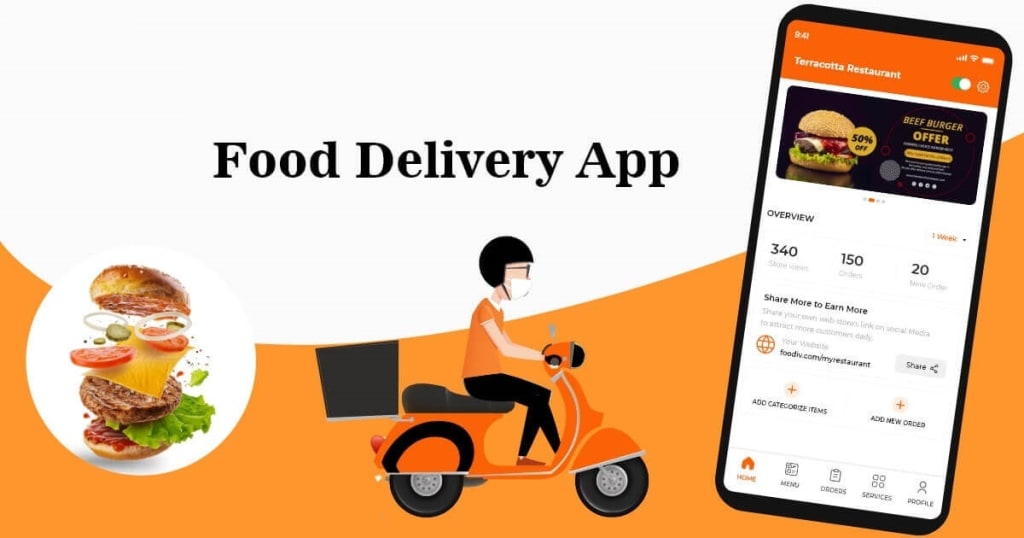Food Application for Organic Restaurant Services – 2024
food delivery application development

Introduction
In today’s world convenience sometimes trumps quality, the desire for healthier and more sustainable dining alternatives has never been stronger. Organic restaurants are becoming more popular as people become more careful of what they eat, thanks to their commitment to delivering fresh, locally produced, and pesticide-free products. This trend toward a healthy lifestyle has resulted in the creation of novel food apps tailored exclusively to organic eateries. In this post, we’ll look at the many parts of a food application created for an organic restaurant, emphasizing the benefits, features, and overall influence it may have on both consumers and the restaurant industry.
The Organic Restaurant Movement: An Overview
Before getting into the mechanics of a food application for organic restaurants, it’s critical to grasp the ideals that drive the organic restaurant movement. Organic eating extends beyond the lack of industrial pesticides and genetically modified organisms (GMOs). It incorporates a comprehensive strategy that prioritizes sustainable farming operations, animal welfare, and the general health of the ecosystem.
To reduce their carbon impact and promote local farmers, organic restaurants focus locally produced, seasonal food. They frequently provide a broad menu that appeals to a variety of dietary needs, such as vegan, vegetarian, and gluten-free alternatives. The difficulty for these restaurants is to successfully communicate to potential consumers their dedication to these ideals while also offering a seamless eating experience that corresponds with their beliefs.
Food Applications’ Role in Organic Dining
Food apps have become an important component of the modern eating experience, providing convenience, accessibility, and improved communication between establishments and customers. A dedicated food application can help organic restaurants bridge the gap between their ethics and the expectations of sophisticated guests.
Transparency in Ingredients and Digital Menus:
One of the key features of a food application for an organic restaurant is a digital menu that goes beyond the standard list of dishes. It provides detailed information about the origin of ingredients, farming practices employed, and certifications obtained. This transparency helps build trust with customers who are keen on understanding the journey of their food from farm to plate.
Customization for Dietary Preferences:
Organic restaurants usually cater to a broad range of dietary requirements, such as vegetarian, vegan, and gluten-free options. Customers may customize their meals utilizing a well-designed food app based on their dietary restrictions or preferences. This not only enhances the dining experience but also ensures that the restaurant can accommodate a bigger number of clients.
Real-time Updates on Seasonal Specials:
Seasonal menus, which emphasize the use of fresh, locally available products, are a feature of organic eating. A food application provides real-time updates on seasonal specials, allowing users to experiment with various recipes and flavors based on ingredient availability. This dynamic technique keeps the cuisine interesting and accords with organic eateries’ sustainability policies.
Ordering and Delivery Services:
The ease of ordering food using a smartphone app cannot be emphasized enough. An organic restaurant food app simplifies the ordering process by including features such as in-app payment, order tracking, and delivery choices. This not only improves the entire client experience but also meets the increasing need for contactless eating options. With the assistance of online food delivery app development services business owners can elevate their restaurant’s digital presence and streamline the ordering process for their customers.
Educational Content and Sustainability Initiatives:
A food application may be more than just a transactional platform; it can also be an instructional hub, delivering information about organic agricultural techniques, environmental efforts, and the restaurant’s dedication to ethical sourcing. This educational component enhances the eating experience by establishing a stronger bond between the business and its customers.
Benefits for Organic Restaurants
Implementing a food application adapted to the demands of an organic restaurant has various advantages for both the company and its clients.
Increased Visibility and Customer Reach:
A well-designed food application serves as a marketing tool, improving the organic restaurant’s exposure among potential consumers. It acts as a virtual showroom for users looking for organic and sustainable dining alternatives, increasing the restaurant’s client reach.
Enhanced Customer Loyalty:
A specialized food application increases client loyalty by delivering a streamlined and user-friendly experience. Regular customers may quickly discover new menu items, participate in loyalty programs, and receive tailored suggestions based on their tastes, developing a connection with the restaurant.
Efficient Order Management:
Order management is critical for organic restaurants that value the quality and freshness of their goods. A food application simplifies the ordering process, allowing the restaurant to better manage orders, cut wait times, and improve kitchen operations.
Data-Driven Insights:
The integration of analytics tools into a food application gives the restaurant significant data insights. Understanding consumer preferences, popular menu items, and peak ordering periods enables the restaurant to make more educated judgments, enhance its products, and adjust marketing campaigns for greater success.
Adaptability to Changing Trends:
The restaurant sector is ever-changing, with trends and consumer tastes changing all the time. Organic restaurants can quickly adjust to these changes thanks to a food application. The software acts as a flexible platform for innovation, whether it’s adding new menu items, adapting to nutritional trends, or applying eco-friendly packaging.
Challenges and Considerations
While the advantages of a food application for organic restaurants are obvious, there are several problems and concerns to be addressed throughout the development and implementation phases.
Initial Investment and Maintenance Costs:
Creating a personalized food application needs an initial investment in design, development, and continuing maintenance. Organic restaurants, especially smaller ones, must assess these expenses against the possible long-term advantages and return on investment.
Data Security and Privacy:
With the growing reliance on digital platforms, it is critical to ensure the security and privacy of client data. To secure sensitive information and comply with data protection requirements, restaurants must install strong security measures.
User Education and Adoption:
Introducing a food application to a client base that is not always tech-savvy might be difficult. Restaurants should invest in user education and assistance to boost app adoption among their customers.
Integration with Existing Systems:
A food application’s successful functioning requires a seamless connection with current restaurant management systems, such as point-of-sale (POS) systems and inventory management. Compatibility concerns may develop during the installation phase, necessitating careful planning and execution.
The Future of Organic Dining Apps
The future of food applications for organic restaurants promises intriguing potential as the organic eating scene evolves. Several possible developments can improve the organic eating experience while meeting the ever-increasing needs of aware customers.
Supply Chain Transparency Using Blockchain Technology:
The use of blockchain technology in organic restaurants can transform supply chain transparency. Customers may follow the travel of each product from its source to the restaurant’s kitchen by using blockchain. This degree of openness not only coincides with the fundamental values of organic eating, but it also fosters an uninterrupted line of confidence between the restaurant and its customers.
Menu Augmented Reality (AR) Experiences:
Imagine being able to visually visit the vineyard of the winery behind your favorite organic wine or the organic farm where your salad greens were harvested. AR can give customers with immersive menu experiences, allowing them to connect with the sources of their food in a novel and interesting way. This participatory method adds a layer of storytelling to the eating experience, strengthening the consumer-restaurant relationship.
Community Engagement and Collaboration:
Organic restaurants frequently give back to their communities by supporting local farmers and businesses. Future food apps might foster community participation by incorporating collaborative projects such as collaborations with neighboring farmers’ markets or unique discounts for consumers who support local companies. This not only develops neighborhood relationships but also corresponds with the sustainability and community-driven organic eating ideal.
AI-Powered Personalized Recommendations:
Customer preferences and dining patterns may be analyzed using Artificial Intelligence (AI) algorithms. The software may give personalized menu recommendations by analyzing individual tastes and dietary needs, making the eating experience more specialized and delightful for each client. This level of customisation not only increases client happiness, but also fosters the discovery of new organic recipes.
Gamification for Sustainable Practices:
Gamification aspects inside the app can encourage users to adopt more environmentally friendly dining habits. This might include mechanisms that reward people for eating vegetarian or vegan foods, decreasing food waste, or continuously supporting seasonal specials. The software helps to achieve the greater objective of fostering eco-conscious dining habits by making sustainable choices a joyful and rewarding experience.
Virtual Cooking Classes and Culinary Workshops:
Future versions might include virtual cooking lessons or culinary seminars, expanding beyond the typical confines of a food ordering app. This not only offers organic restaurants with an extra revenue stream, but it also allows guests to connect with the restaurant on a deeper level, learning about the creation of organic food and the importance of sustainable cooking procedures.
Overcoming Challenges Through Innovation
While these prospective improvements bring great prospects, tackling the problems associated with organic restaurant food applications is critical. Continuous attempts to simplify user interfaces, improve data security, and offer continual user education will be critical to these apps’ long-term success.
Furthermore, industry collaboration efforts, such as the creation of standardized organic restaurant app frameworks, might assist smaller restaurants in overcoming cost constraints and encouraging wider use. These efforts can help to promote the organic eating movement by establishing a feeling of community among organic eateries.
Conclusion:
The incorporation of food apps, including restaurant’s on-demand delivery app builder, into organic eating is more than just a technology trend; it represents a fundamental shift in the way we perceive and appreciate food. These apps have the potential to transform the future of the organic restaurant sector, making it more accessible, transparent, and engaging for consumers as they evolve. As we traverse the digital dining era, recognizing the symbiotic relationship between technology and organic principles will definitely result in a more conscious and gratifying culinary experience—one that not only delights the taste but also nourishes the spirit and preserves the earth.
About the Creator
Transgenie
Our Delivery Management Software is the ultimate solution for businesses looking to optimize their delivery operations.
https://www.transgenie.io
Enjoyed the story? Support the Creator.
Subscribe for free to receive all their stories in your feed. You could also pledge your support or give them a one-off tip, letting them know you appreciate their work.






Comments
There are no comments for this story
Be the first to respond and start the conversation.